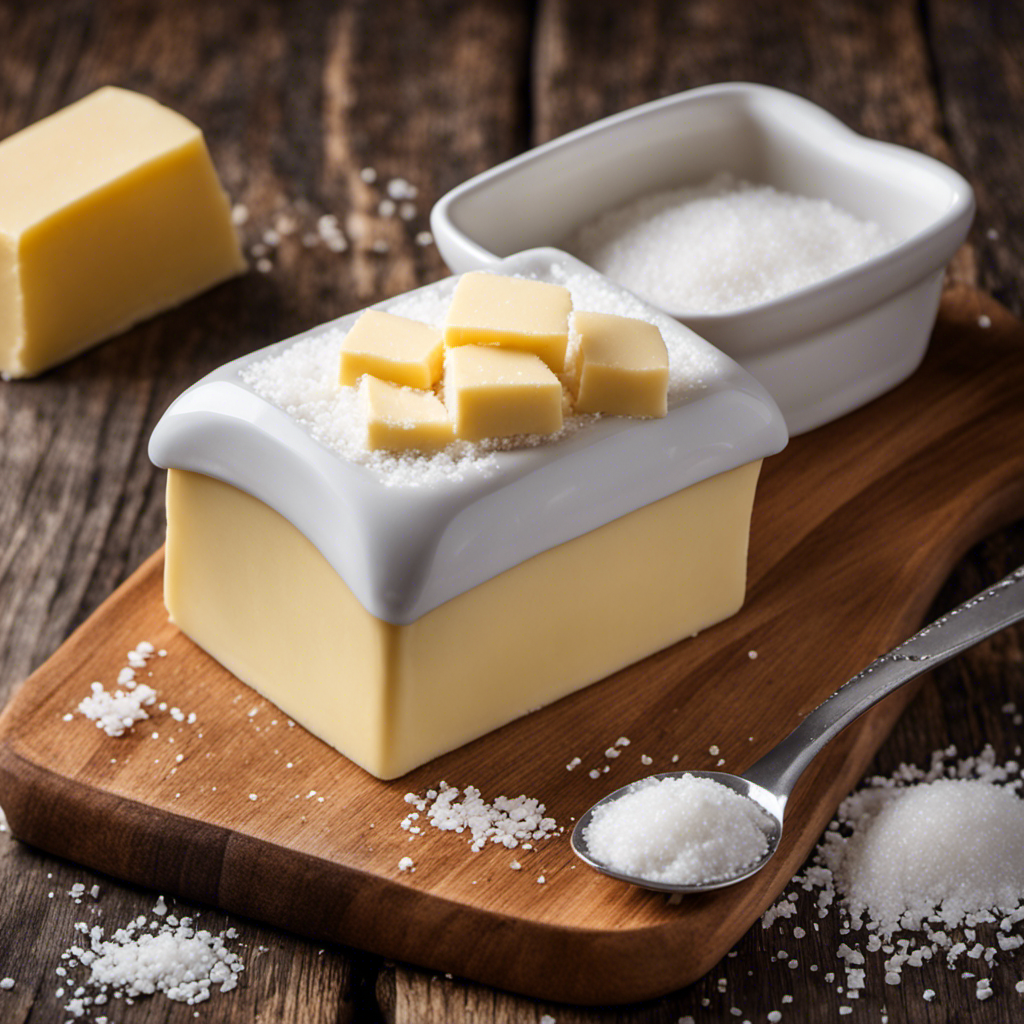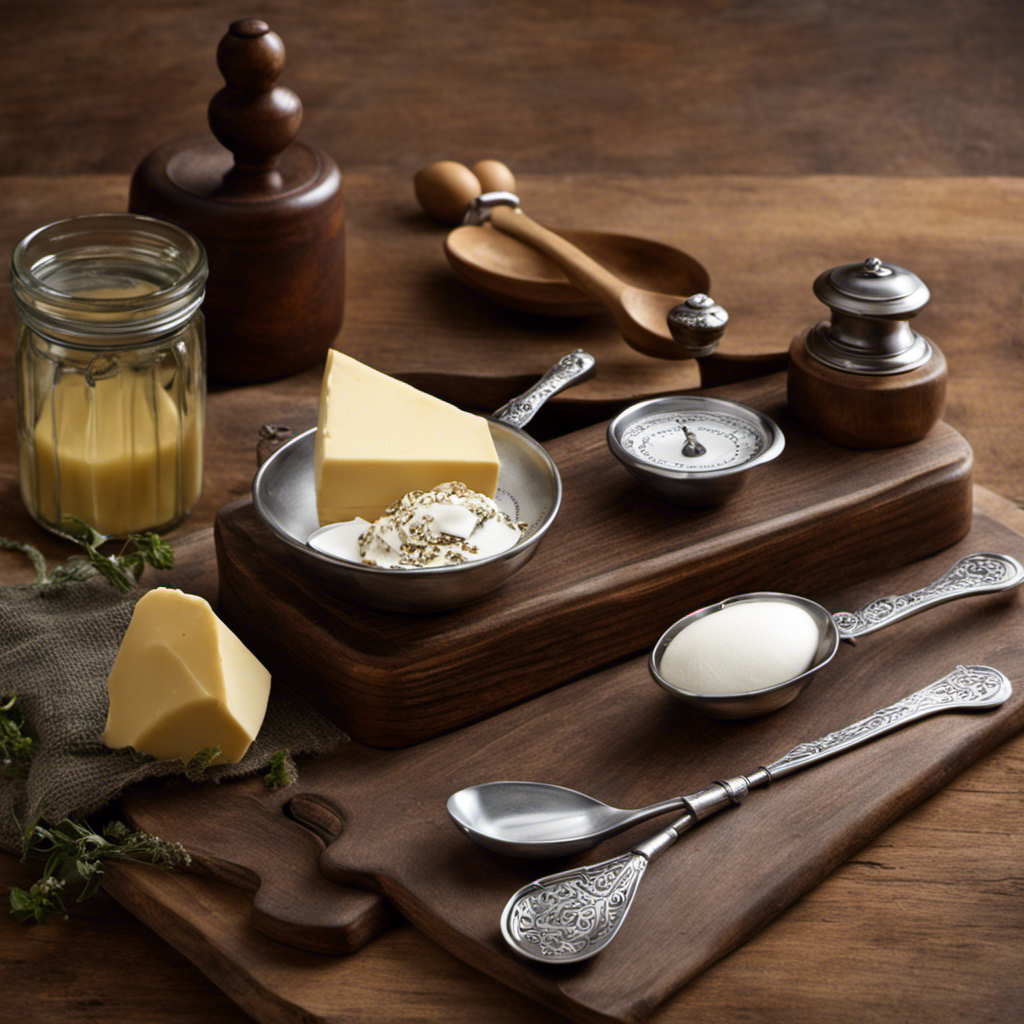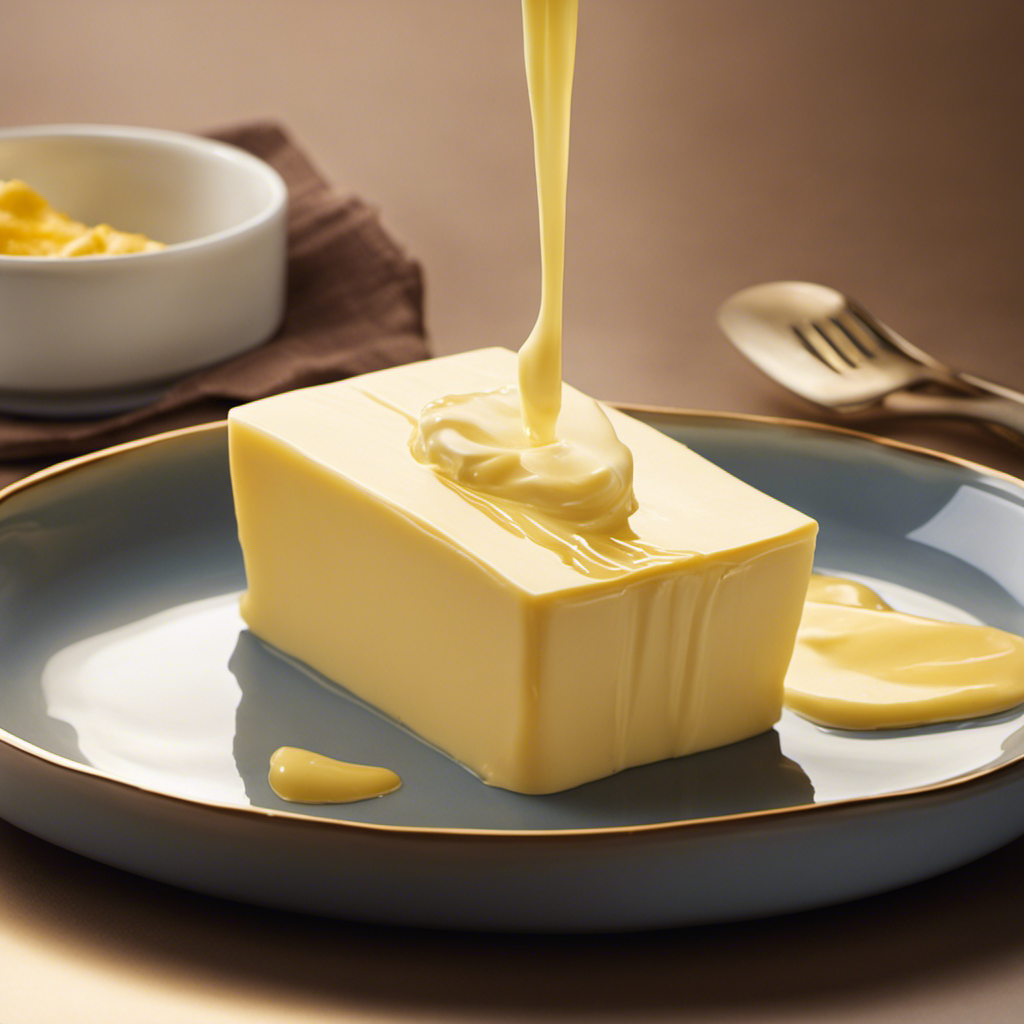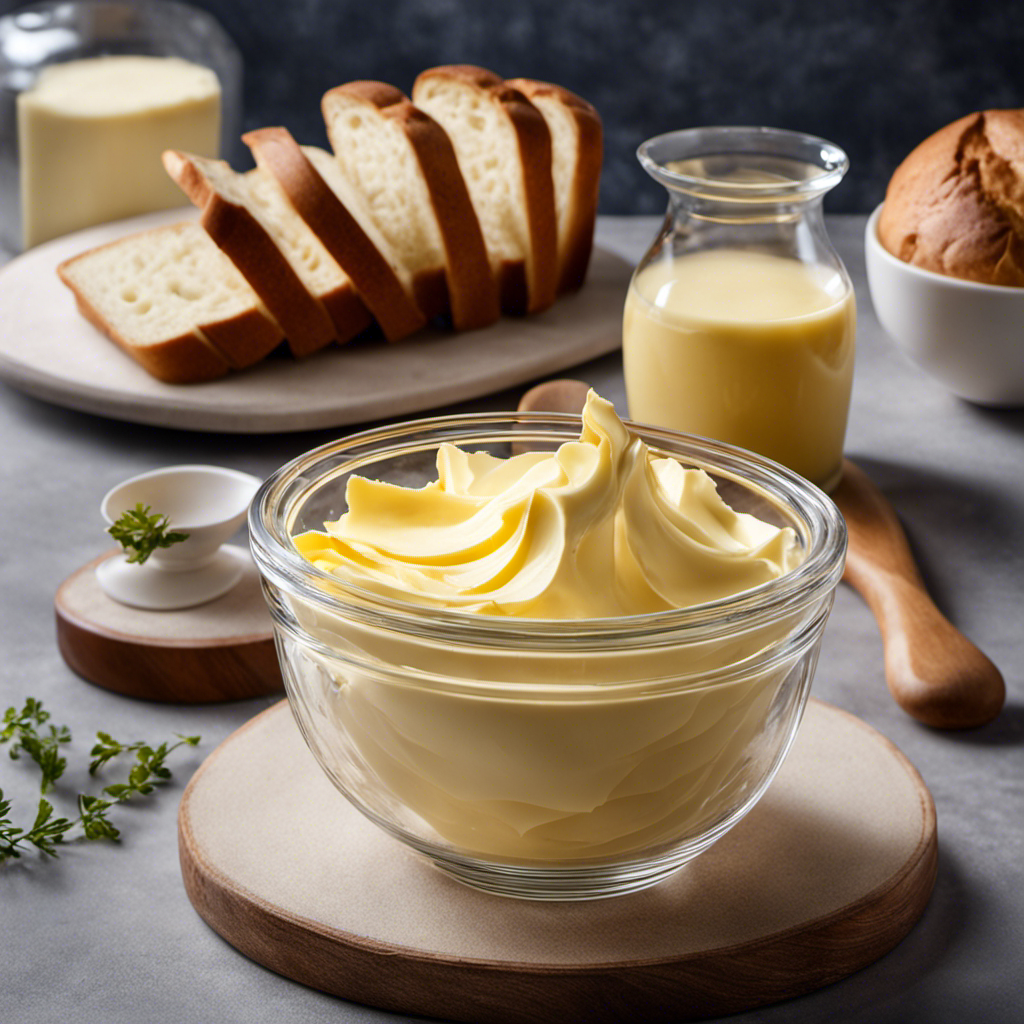I understand your question: “Why should I put salt into unsalted butter?”
Well, let me tell you, the importance of salt in butter goes beyond just enhancing the flavor. It plays a crucial role in preserving the butter and balancing its texture.
In this article, I’ll guide you through the factors to consider when adding salt to unsalted butter, the recommended salt to butter ratio for different culinary uses, and how to properly incorporate salt into your butter.
Get ready to take your butter game to the next level!
Key Takeaways
- The recommended salt to butter ratio varies depending on the culinary use, such as baking, cooking, spreading, seasoning, sauces, and dips.
- When incorporating salt into unsalted butter, it is important to gradually mix small amounts of salt, taste as you go, and consider the intended use and other flavors in the dish.
- Adjusting salt levels based on personal taste preferences involves gradually adding small amounts of salt, experimenting with flavors, and keeping track of the salt amount for future recipes.
- The proper salt ratio is crucial for flavor balance and enhancing the natural flavors of butter. Too little salt results in a bland flavor, while too much salt overpowers the butter’s taste. Accurate measurements ensure a harmonious blend of flavors and unlock the full potential of butter’s richness and complexity.
Understanding the Importance of Salt in Butter
Understanding the importance of salt in butter is crucial for enhancing the flavor of your dishes. When it comes to baking, salt plays a vital role in balancing sweetness and enhancing other flavors. It helps to bring out the natural flavors of ingredients and adds depth to your baked goods.
In addition to its flavor-enhancing properties, using salted butter also offers some benefits. Firstly, it provides convenience, as you don’t have to worry about adding extra salt separately. Secondly, salted butter tends to have a longer shelf life due to its preservative properties. Lastly, the small amount of salt in salted butter can help to preserve the texture and structure of baked goods, resulting in a better outcome.
Factors to Consider When Adding Salt to Unsalted Butter
When using unsalted butter, consider the factors that come into play when determining the right amount of salt to incorporate. Adjusting salt levels in unsalted butter can be a delicate task, as it requires careful consideration of several factors. Here are three important factors to consider:
-
Personal preference: Everyone’s taste buds are unique, so it’s important to consider your personal preference for saltiness. Some may prefer a subtle hint of salt, while others may enjoy a bolder flavor.
-
Recipe requirements: Different recipes may call for different levels of salt. Consider the overall flavor profile of the dish and adjust the salt accordingly to ensure a well-balanced final result.
-
Sodium intake: It’s important to be mindful of your sodium intake. If you’re watching your salt consumption, you may want to use less salt or opt for a low-sodium alternative.
Recommended Salt to Butter Ratio for Different Culinary Uses
For different culinary uses, it’s essential to know the recommended ratio of salt to butter. The ratio of salt to butter can vary depending on the dish you’re preparing. Here is a table that outlines the recommended ratios for some common culinary uses:
| Culinary Use | Ratio of Salt to Butter |
|---|---|
| Baking | 1/4 teaspoon per stick |
| Cooking | 1/2 teaspoon per stick |
| Spreading | 1/8 teaspoon per stick |
| Seasoning | 1/8 teaspoon per stick |
| Sauces and dips | 1/4 teaspoon per stick |
These ratios are a general guideline, and you can adjust them according to your personal taste preferences. It’s important to note that using unsalted butter allows you to have more control over the saltiness of your dish. So the next time you’re using unsalted butter, keep these recommended ratios in mind to achieve the perfect balance of flavors in your culinary creations.
Tips for Properly Incorporating Salt Into Unsalted Butter
To properly incorporate salt into your unsalted butter, start by gradually mixing small amounts of salt into the softened butter, using a fork or spatula. This allows the salt to evenly distribute throughout the butter, enhancing its flavor.
Here are three tips to help you achieve the perfect balance of saltiness in your butter:
-
Taste as you go: Add a pinch of salt at a time, tasting the butter after each addition. This way, you can adjust the amount of salt to suit your preference.
-
Use high-quality salt: Opt for sea salt or kosher salt, as they have a more pronounced flavor compared to table salt. This will help enhance the buttery taste.
-
Consider the intended use: Different recipes require different amounts of salt. Keep in mind the other ingredients and flavors in your dish to ensure a harmonious balance.
Adjusting Salt Levels Based on Personal Taste Preferences
If you want to achieve the perfect balance of saltiness in your dishes, start by gradually incorporating small amounts of salt into your softened butter. Adjusting seasoning is crucial in order to cater to personal taste preferences. Experimenting with flavors allows you to find the right amount of salt that suits your palate.
When adjusting the salt levels, it’s important to remember that a little goes a long way. Start by adding a pinch of salt to a small amount of softened butter and mix it well. Taste and assess the saltiness. If it’s not enough, gradually add more salt, tasting along the way until you achieve the desired level of saltiness.
Remember to keep track of the amount of salt you’re adding, so you can replicate the perfect balance in future recipes.
Common Mistakes to Avoid When Adding Salt to Unsalted Butter
When it comes to adding salt to unsalted butter, it is important to understand the proper salt ratio and how to balance flavors accurately.
The proper salt ratio ensures that the butter is seasoned just right, enhancing its taste without overpowering it.
Balancing flavors accurately is crucial in order to achieve a harmonious blend of salty and buttery notes in your dishes.
Proper Salt Ratio
You should always aim for a proper salt ratio when adding salt to unsalted butter. The right amount of salt can enhance the flavor of the butter, making it more delicious and satisfying. Here are three reasons why proper salt measurement is important:
-
Balance: Adding too little salt can result in a bland and lackluster taste, while adding too much salt can overpower the butter’s natural flavors. Achieving the proper salt ratio ensures a harmonious balance of flavors.
-
Depth: Salt is a powerful flavor enhancer that can bring out the richness and complexity of the butter. By using the correct amount, you can unlock the full potential of the butter’s taste.
-
Enjoyment: The pleasure of eating is deeply connected to taste. When you get the salt ratio right, every bite of butter becomes a delightful experience, leaving you wanting more.
Balancing Flavors Accurately
To achieve a harmonious balance of flavors, it’s important to accurately balance the flavors in your dish. Accurate measurement plays a crucial role in achieving this balance.
When it comes to flavor enhancement, precise measurements ensure that no one flavor dominates the dish. Whether it’s salt, spices, or other seasonings, adding the right amount is key. Too much salt can overpower the other flavors, while too little can result in a bland dish.
By using accurate measurements, you can enhance the flavors without overwhelming them. The goal is to create a dish where all the flavors work together in perfect harmony.
Frequently Asked Questions
Can I Use Any Type of Salt When Adding It to Unsalted Butter?
When adding salt to unsalted butter, it’s important to consider different types of salt for different flavors. Using unsalted butter in recipes allows for better control of the overall saltiness.
How Long Can I Store Salted Butter in the Refrigerator?
Salted butter can be stored in the refrigerator for up to a month. The salt acts as a preservative, preventing the growth of bacteria and extending the shelf life of the butter.
Can I Substitute Unsalted Butter With Salted Butter in a Recipe?
Yes, you can substitute unsalted butter with salted butter in a recipe. However, keep in mind that the taste and texture may be slightly different due to the added salt.
Does Adding Salt to Unsalted Butter Affect Its Shelf Life?
Adding salt to unsalted butter does not significantly affect its shelf life. However, it can alter the texture and nutritional value. It’s important to add the right amount of salt to achieve the desired taste and balance.
Can I Add Herbs or Spices to Salted Butter for Added Flavor?
Adding herbs or spices to salted butter enhances its flavor. However, it’s important to note that using unsalted butter in baking allows for better control of the salt content in the recipe.
Conclusion
In conclusion, understanding the importance of salt in butter is crucial for achieving culinary perfection. By considering factors such as personal taste preferences and culinary uses, one can determine the ideal salt to butter ratio.
Properly incorporating salt into unsalted butter ensures a harmonious blend of flavors. However, it is essential to avoid common mistakes that may compromise the desired outcome.
So, remember, the right amount of salt can transform unsalted butter into a symphony of taste, elevating your dishes to new levels of deliciousness.










